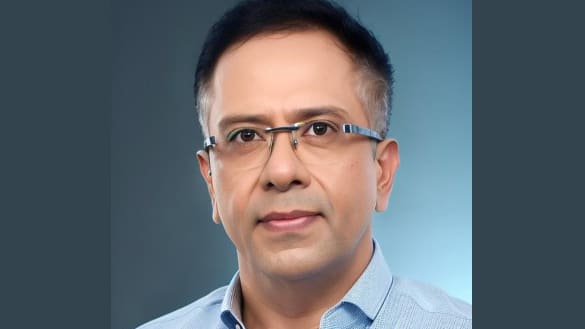Pankaj Vasani, Group CFO of Cube Highways Trust discusses his three-pronged financial prudence philosophy: avoid asset-liability mismatches, maintain flexibility, and keep ample headroom for future growth.

Pankaj Vasani, Group CFO of Cube Highways Trust
In conversation with FECFO, Pankaj Vasani, Group CFO of Cube Highways, attributed the significant 22% EBITDA growth, a key financial metric indicating the Trust's operational performance, to steady traffic and recent acquisitions.
Vasani explained that the infrastructure investment trust (InvIT) in the roads and highways sector, Cube Highway Trust’s approach is to balance short-term flexibility with long-term stability, keeping leverage well within limits. He emphasized that the Trust's growth will continue to be disciplined, diversified, and accretive to unit holder value, instilling confidence in the company's future performance.
His immediate priorities, he said, are optimizing debt, sustaining distributions, and strengthening governance—anchored by the principles of resilience, prudence, and transparency, which he believes are essential for long-term investor trust. Here are the excerpts highlighting Vasani’s capital strategy and outlook.
Q1 FY26 has seen robust topline and EBITDA growth with a 22% YoY rise. What are the key operational or strategic levers that drove this performance, and can we expect similar momentum in Q2 and the rest of FY26?
In Q1, revenues from operations grew 19.2% YoY to ₹944 crore, and EBITDA rose 22% to ₹702 crore. This was driven by strong traffic growth of 6.3%, toll revisions, and the full-quarter contribution of NAMEL (NAM Expressway Limited (NAMEL) is a special purpose vehicle, that is incorporated to implement a lane expansion project, operates the 212 km, four-lane road stretch connecting the states of Andhra Pradesh and Telangana, connecting Narketpally and Medarametla) alongside incremental inflows from our new annuity assets.
We also maintained stable costs despite expanding to 27 assets. As we advance, the portfolio fundamentals remain strong. While traffic trends, macroeconomic conditions, and seasonality may influence Q2 and the rest of FY26, our diversified mix of toll and annuity assets positions us well to sustain our performance.
With Rs 13.3 billion in commercial paper issued and debt levels still within the threshold, what is your capital-raising outlook for FY26–FY28? Will you continue to rely on short-term instruments, or are longer-term borrowings or equity infusions under consideration?
Our debt-to-AUM ratio stands at ~49.6%, comfortably within the unitholder-approved ceiling of 55% and well below the 70% regulatory limit. Over the past two years, we have actively diversified our liability profile, moving from 0% to approximately 30% fixed-rate borrowings.
We've issued bonds across a broad spectrum of maturities, from short-dated commercial paper to long-term instruments of up to 12 years, ensuring repayments are staggered in line with future cash flows.
A significant portion of our recent issuances has a long tenor, while our floating-rate obligations carry a 19-year door-to-door profile with annual amortization. Our endeavour is simple: avoid asset-liability mismatches, maintain flexibility, and keep ample headroom for future growth.
Could you walk us through your pipeline of asset acquisitions and share any growth guidance you have for fiscal years 2027 and 2028, including scale, regions, or asset diversification?
Our AUM rose to ₹36,543 crore this quarter, helped by the acquisition of two annuity assets in Jammu & Kashmir. This strengthened our annuity share of the portfolio to 33%, with nine annuity assets out of the 27 assets currently under our handling, improving both diversification and cash flow stability.
On the pipeline, we continue to evaluate opportunities. While we do not give formal forward guidance, our focus will remain on disciplined, accretive acquisitions, with an emphasis on balancing toll and annuity exposures. Growth will be pursued with a clear focus on unitholder value and portfolio resilience.
Every acquisition must be accretive, diversified, and value-adding —scale for the sake of scale is not our playbook.
Given Cube InvIT’s consistent focus on compliance, risk management, and unitholder returns, what are your top 2–3 CFO priorities as you navigate fluctuating interest rates, potential policy changes, and currency risks?
Our priorities are threefold. First, we will continue to optimize our liability structure. Approximately 30% of our borrowings are already fixed-rate, which shields us from interest rate fluctuations; we will continue to evaluate the mix of our borrowings.
Second, to maintain distribution integrity, ensure stable, inflation-linked cash flows are distributed to unitholders quarterly.
Third, to keep Cube’s governance and compliance at the forefront. Regulatory clarity and risk management frameworks are key areas of focus for me. These priorities help us remain resilient in an environment of policy shifts, currency fluctuations, and evolving market conditions.
As a finance leader at the helm of a large InvIT with global institutional investors, how do you balance short-term funding needs with long-term value creation?
For toll roads, liquidity is never a concern - we collect revenues daily, while our obligations are monthly or quarterly. The entire Cube portfolio is fully operational and cash-generating, and our focus is on distributing this cash efficiently; we rarely need to borrow for operational purposes. Borrowing typically comes into play only when we add assets, and even then, it is structured for the long term.
InvITs are designed to minimize the typical trade-off between short-term liquidity and long-term value creation, an underappreciated yet vital feature of this asset class. Our approach is to maintain prudent leverage, ensure consistent distributions, and foster investor confidence through a long-term value lens.
What leadership lessons have shaped your strategic approach at Cube?
Resilience, prudence, and transparency - that’s our playbook for long-term trust. Our job is not about short-term optics, but about creating sustainable value over the long term.
Empower your business. Get practical tips, market insights, and growth strategies delivered to your inbox
By continuing you agree to our Privacy Policy & Terms & Conditions
